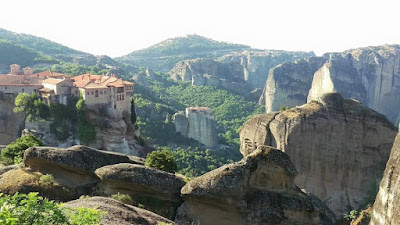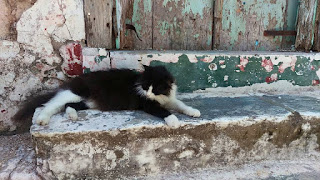We got up early again on Wednesday morning – story of our
lives!- and took a taxi into Athens because the metro line we usually take into
the city was closed for some reason that morning. Luckily, we had heard the announcement that
the train wouldn’t be running on the way back to Marathon the night before, or
we probably would have missed our tour!
We got to the hotel and got some coffee at Solo Café again. I’m really growing attached to the people who
work there. They only speak enough
English to take our orders, but they always look like they’re having a good
time, even early in the morning.
We got on the bus and had a two hour ride to Delphi, which is
located north of Athens on Mount Parnassus.
The area was gorgeous. The site
of Delphi is located near the peak of one of the mountains, so you have very
striking views from nearly every angle.
We also got a ton of exercise walking up the slope to see the stadium,
which was a good ten minute walk away from the rest of Delphi, and then running
back down the mountain because we were late for our bus! Thankfully, we all made it! We weren’t even the last ones. Carla was very glad that she had the help of
her walking stick.
 |
| The Stadium |
 |
| This is where the oracle would have been |
 |
| The Treasury of the Athenians |
Then it was back on the bus for three and a half more hours
of driving to get to the city of Kalambaka for our overnight stay in the Hotel
Amalia there. These hotels are all gorgeous! We had a half an hour before dinner, so I
spent some time wandering around and taking pictures. I went into a courtyard in the middle of the
hotel to look! around. There was a little waterfall and a ton of flowers. It was all very pretty, but someone shut the
door behind me and locked me in the courtyard!
I was stuck for ten minutes or so before Mom came and found me and let
me back in so I could eat dinner. Her
mama-senses must have been tingling or something, haha!
That night the news in Greece was all about the riots going
on at Syntagma Square outside the Parliament building. The Greek prime minister has been forced into
accepting stringent austerity measures proposed by the European Union (EU) and
the International Monetary Fund (IMF) in order to be eligible for loans so that
they can stay in the EU and continue to use the Euro. Unfortunately, he accepted these measures
after the Greek people had voted against accepting any additional measures in a
recent referendum. The irony of a
government going against the wishes of its people here, in the place where
democracy was born, is not lost on me, nor is it lost on many of the people
living here. There have been many
protests in Syntagma Square since we’ve been there, but they have all been
peaceful. That night, as the parliament
voted to accept the austerity measures, something switched in the crowd and a
protest became a riot. There were
several people throwing Molotov cocktails and the police were forced to use tear
gas. There was at least one news van in
flames. I can’t imagine how scary it
must have been to have been staying in one of the hotels in the square that
night. Luckily, we were all very far
away from the area. When we walked
through the square the next evening, you could hardly tell that anything had
happened.
The next morning we got up and had breakfast in the
hotel. The food at these hotels is way
better than the food they serve at Golden Coast, we were all very
impressed. Then we hopped on the bus and
drove about 30 minutes toward some pretty insane rock formations with
monasteries on top! The formations in
Meteora used to be mountains, but a combination of water erosion and
earthquakes turned them into several free-standing rock pillars. The result is awesome – literally. We all kept looking out the window, completely
awestruck. You really feel very small
when you look at them.
Apparently, a guy named Athanasios had a similar reaction to
the rocks in the 14th century, so he decided it would be a good idea
to build a monastery at the top of one.
I honestly have no idea how they got all the stone they needed up there
to start building, but eventually they rigged up a pulley system and used carts
or nets to haul people up the side of the rocks. It wasn’t until the early 1800s that someone
had the bright idea to carve stairs into the side. Even so, the monasteries are not easy to get
to (which, I imagine, was sort of the idea – weed out the unworthy or insincere
and whatnot). This first monastery was
named Meteoron, and is where the whole area gets its name.
 |
| The stairs we had to climb to get up to the monastery |
Once we finally got up to Meteoron, it turned out that the
inside of the monastery was just as impressive as its surroundings. We were not allowed to take pictures of the
inside the church itself, but the walls and ceilings were all completely
covered in frescos in both the Macedonian and Cretan styles. This style tries to make the figures look
unrealistic in order to take people away from the burdens of their everyday
life. Figures who are most important are
the largest and the colors of the paintings are mostly primary colors with very
striking gold accents. Most of the
frescos depicted the martyrs and saints of the Bible and how they died. There were some extremely gorey
paintings! I saw one depiction of a male
martyr losing his head, blood everywhere, and another of a female martyr
getting her breasts cut off. I was
surprised at how violent some of the images were. Closer to the altar there were more depictions
of saints, angels, the founders of the monastery, the apostles, Mary, and
Jesus. These were less graphic, but
significantly more stunning. The furniture in the room was all elaborately
carved dark wood. I could find animal
figures woven through leaves and vines on most of the pieces. Below are examples of similar art from other places in the monastery.
As well as the art there were some human remains on display
in the sanctuary as well. There were
three skulls in boxes with little circles cut out so the very top of the skull
was visible to the eye as well as two human arm bones (looked like a humerus
and an ulna to me) in a chest with the lid open. These were all displayed in a glass case so
that they could not be touched or damaged.
They are apparently the remains of some of the founders of the monastery
and are rather holy. There were also
some museums in the monastery. We could
see what military uniforms looked like throughout Greek history as well as old
religious artifacts. There were
BEAUTIFUL hand written gospels and religious texts dating from the 13th
century that it just killed me not to be able to take pictures of.
 |
| Wine/beer anyone? |
Oh, and did I mention the views were amazing? The rock we were on is called Platys Lithos
and is over 2,000 feet high.
After Meteoron we visited St. Stephen’s monastery, which has
been converted into a convent. It was
very similar to Meteoron, but not nearly as old. They are also in the process of redecorating
the sanctuary, so we were able to see the paintings more clearly. Then we got back on the bus and started the five
and a half hour drive back to Athens. We
arrived back at the hotel at about 8 PM and I proceeded to veg out for the rest
of the night.
Today is our last day at the resort. I will probably try to spend a little time by
the pool and at the beach. Dad and I are
going to rent bicycles and go to a little town that is nearby this evening when
it cools down a bit. Tomorrow we go to
the airport and head home. This will
probably be the last blog post of this trip unless something really exciting
happens on the way back to the States.
Thank you all for reading! I hope
you enjoyed hearing about our travels.
LOVE!
Amelia

















































